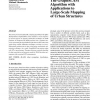Free Online Productivity Tools
i2Speak
i2Symbol
i2OCR
iTex2Img
iWeb2Print
iWeb2Shot
i2Type
iPdf2Split
iPdf2Merge
i2Bopomofo
i2Arabic
i2Style
i2Image
i2PDF
iLatex2Rtf
Sci2ools
IJRR
2006
2006
The Graph SLAM Algorithm with Applications to Large-Scale Mapping of Urban Structures
This article presents GraphSLAM, a unifying algorithm for the offline SLAM problem. GraphSLAM is closely related to a recent sequence of research papers on applying optimization techniques to SLAM problems. It transforms the SLAM posterior into a graphical network, representing the log-likelihood of the data. It then reduces this graph using variable elimination techniques, arriving at a lowerdimensional problems that is then solved using conventional optimization techniques. As a result, GraphSLAM can generate maps with 108 or more features. The paper discusses a greedy algorithm for data association, and presents results for SLAM in urban environments with occasional GPS measurements. KEY WORDS--SLAM, robot navigation, localization, mapping
| Added | 13 Dec 2010 |
| Updated | 13 Dec 2010 |
| Type | Journal |
| Year | 2006 |
| Where | IJRR |
| Authors | Sebastian Thrun, Michael Montemerlo |
Comments (0)

